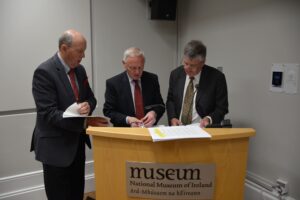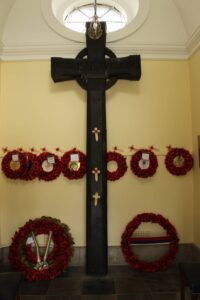 The Trustees of the Inniskillings Museum conducted the Salute to Waterloo reflecting the bicentenary of the Battle of Waterloo which took place on 18 June 1815, on Saturday 30 May, in Enniskillen, County Fermanagh.
The Trustees of the Inniskillings Museum conducted the Salute to Waterloo reflecting the bicentenary of the Battle of Waterloo which took place on 18 June 1815, on Saturday 30 May, in Enniskillen, County Fermanagh.
A Bicentenary Commemoration Service was held in Saint Macartin’s Cathedral conducted by the Dean, The Very Rev. Kenneth Hall and the Sermon was delivered by The Bishop, The Right Rev. McDowell.
Later in Enniskillen Castle, a narrative display of regimental band music and re-enactment, involving the Band of the Royal Irish Regiment, the Pipes and Drums of the Royal Dragoon Guards and the Irish Arms Historical Reproductions, was a fitting manner to honour the Irish Soldier on the occasion of the bicentenary of Waterloo. The Right Honourable Viscount
The Salute to Waterloo – Honouring the Inniskillings was the Museum’s flagship commemorative event for the bicentenary and honours the pivotal role of both Inniskillings Regiments at this epic turning point in European history – the 6th Inniskilling Dragoons and the 27th (Inniskilling)Regiment of Foot. The permanent galleries of the Inniskillings Museum can be viewed by the general public in the Castle Keep and includes a temporary exhibition titled “The Field of Waterloo”.
The Military Heritage of Ireland Trust (CLG) was represented by its Chairman Brigadier-General Paul Pakenham (Retd). Trust Directors Major-General David O’Morchoe (Retd) and Colonel Harvey Bicker (Retd) were also in attendance. The Royal Irish Regiment was represented by Colonel Mike Murdoch, Deputy Commander of the 38 (Irish) Brigade and Deputy Colonel of The Royal Irish Regiment.
Photographs of the Salute to Waterloo are posted on the Trust’s Website Flickr Account.
6th (Inniskilling) Dragoons
The 400 men of the 6th Inniskilling Dragoons deployed to Waterloo in a newly designed uniform issued in 1812. Their primary weaponry was a short musket with a rate of fire of 3 rounds per minute and the 1796 version of the heavy cavalry sabre.
Two brigades of heavy cavalry (Household Brigade and the Union Brigade) were deployed at the commencement of hostilities at 1400hrs, neither of which had battle experience. The Dragoons formed part of the Union Brigade alongside the 1st Royal Dragoons and the 2nd Royal North British Dragoons (Scots Greys). The Union Brigade was under the command of General Ponsonby from County Cork.
The Household Brigade engaged the French cavalry and the Union Brigade the French infantry. Having moved through the French infantry, the Inniskilling Dragoons advanced on the French artillery but were attacked by French cavalry, before rescue by the Vandaleurs Light Dragoons. Later, the combined units of the heavy cavalry brigades, including the Inniskilling Dragoons drove the French cavalry efforts to defeat the allied infantry squares. At the end of hostilities, 193 of the 400 Inniskilling Dragoons were either dead or wounded.
27th (Inniskilling) Regiment of Foot
The 27th (Inniskilling) Regiment of foot was the only Irish infantry regiment at the Battle of Waterloo. With a strength of 747 personnel, recruiting throughout Ireland, the Regiment had a significant family tradition, most were Roman Catholics and a considerable number were native Irish speakers. They wore redesigned headdress issued in 1812, later to be called the Belgic shako and carried a heavy musket and ammunition.
The Regiment arrived on the battlefield at 1100hrs on 18 June, part of the 10th Brigade, under the command of Sir John Lambert and was subsequently deployed into the front line, a key position in the centre of Wellington’s line of battle on the forward slope of key terrain. Under constant fire from French artillery and cavalry attacks, the Regiment suffered considerable causalities. For the cavalry attacks, the Regiment formed square, allowing the defenders to fire volleys at the attackers. If the Regiment failed to hold its position, Wellington’s line would have been breached.
An officer of the Rifle Brigade described the scene at 1900hrs: “the 27th Regiment were lying literally dead, in square, a few yards behind us.” Wellington later said: “they (the 27th) saved the centre of my line at Waterloo.” Napoleon commented: “that regiment with the castles on their caps is composed of the most obstinate mules I ever saw; they don’t know when they are beaten.”
Of the 747 officers and men who engaged with the French, 486 were either killed or wounded. Over 55,000 were killed or wounded during the Battle of Waterloo.
18th Hussars
The 18th Hussars, an Irish Regiment of light dragoons, raised by the Earl of Drogheda in 1759 also fought in the Battle of Waterloo, in the 6th Cavalry Brigade on Wellington’s left flank. The 18th Hussars executed the last cavalry charge on 18 June, supporting the centre of the line, its casualties were 12 killed and 73 wounded.
Acknowledgement
The Inniskillings Museum’s excellent publication titled “The Inniskillings at Waterloo” was used as the primary source of information on the 6th (Inniskilling) Dragoons, the 27th (Inniskilling) Regiment of Foot and the 18th Hussars.




